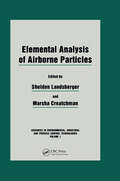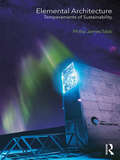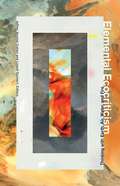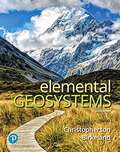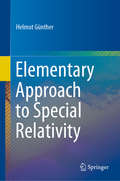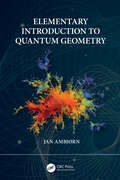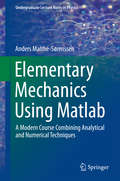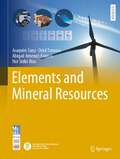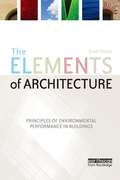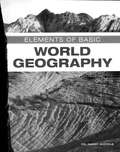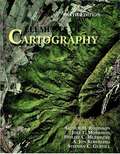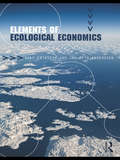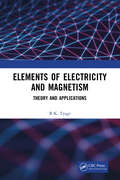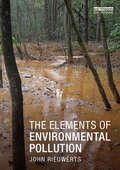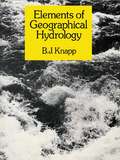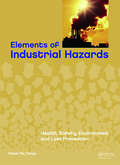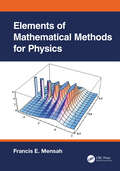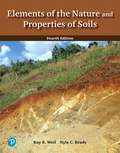- Table View
- List View
Elemental Analysis of Airborne Particles
by Sheldon Landsberger Marsha CreatchmanAn increased standard of living in developed and developing countries has brought about a distinct rise in pollution. The problem of air pollution has specifically increased the public's awareness of the environmental and health-related consequences resulting from modern day industrial technology. This detailed collection of works devoted to the most popular methods in elemental analysis of airborne particles offers investigators a comprehensive book on the most common laboratory analytical methods currently used in trace element analysis. Discussed are atomic absorption spectrometry, inductively coupled plasma, atomic emission, particle induced gamma ray analysis, particle elastic scattering and Rutherford backscattering, and neutron activation analysis. Specific sections on quality assurance/quality control and source receptor modeling have also been included.
Elemental Architecture: Temperaments of Sustainability
by Phillip James TabbElemental Architecture presents a new and refreshing approach to sustainable architectural practice. Going beyond the standard performance-based and quantitative sustainable measures, it incorporates a broader framework of considerations, including the more poetic and noetic possibilities of environmental design. The book is structured around the ancient Greek and medieval alchemists’ system of the Five Temperaments: fire, earth, air, water, and ether. Phillip James Tabb examines how these elements produce both positive and negative environmental forces which have an impact on architectural design – from drinking water and fresh air to torrential floods and tornados. He shows how responding to or enhancing these forces can help us to create a more sustainable, healthy, and purposeful architecture. To illustrate this, each chapter draws on seminal contemporary works of architecture, from Peter Zumthor’s Bruder-Klaus Field Chapel to Frank Lloyd Wright’s masterpiece at Fallingwater. These examples are accompanied by over a hundred high-quality illustrations. Expanding the discussion of sustainability to include phenomenological as well as qualitative considerations, Elemental Architecture is ideal for students and researchers with an interest in sustainable architecture and architectural theory.
Elemental Ecocriticism: Thinking with Earth, Air, Water, and Fire
by Jeffrey Jerome Cohen Lowell DuckertFor centuries it was believed that all matter was composed of four elements: earth, air, water, and fire in promiscuous combination, bound by love and pulled apart by strife. Elemental theory offered a mode of understanding materiality that did not center the cosmos around the human. Outgrown as a science, the elements are now what we build our houses against. Their renunciation has fostered only estrangement from the material world. The essays collected in Elemental Ecocriticism show how elemental materiality precipitates new engagements with the ecological. Here the classical elements reveal the vitality of supposedly inert substances (mud, water, earth, air), chemical processes (fire), and natural phenomena, as well as the promise in the abandoned and the unreal (ether, phlogiston, spontaneous generation). Decentering the human, this volume provides important correctives to the idea of the material world as mere resource. Three response essays meditate on the connections of this collaborative project to the framing of modern-day ecological concerns. A renewed intimacy with the elemental holds the potential of a more dynamic environmental ethics and the possibility of a reinvigorated materialism.
Elemental Geosystems
by Robert Christopherson Stephen Cunha Charles Thomsen Ginger BirkelandFor introductory physical geography courses. <p><p>Explore Earth’s dynamic, changing systems <p><p>Among the most highly regarded textbooks in physical geography, Robert Christopherson’s best-selling Elemental Geosystems retains its unparalleled currency, accuracy, rich integration of climate change science, and dynamic multimedia program. <p><p>Organized around the natural flow of energy, materials, and information, subjects are presented in the same sequence in which they occur in nature―an organic, holistic approach that is unique in this discipline. The 9th Edition features updated content and new Mastering Geography activities, while also incorporating new visual media, active learning activities, and visual tools to help student engagement and mastery.
Elementary Approach to Special Relativity
by Helmut GüntherThis book presents an alternative representation of Einstein's Special Theory of Relativity, which makes Special Relativity much more comprehensible. Moreover, one will come across a fundamental relationship between the Special Theory of Relativity and the mechanics of space lattice. In all previous formulations, the Einsteinian special principle of relativity, in one or the other form is used as the starting point for Special Relativity. In correspondence to this principle, one takes it as granted apriori, that all observers independent of their uniform motion to each other measure one and the same propagation velocity of a light signal. This book is thought of as a lecture for physicists, mathematicians and computer scientists and concentrates on the students of these fields. The book should reach a broad circle of interested readers from the fields of natural sciences and philosophy and provide and invigorating experience for engineers.
Elementary Introduction to Quantum Geometry
by Jan AmbjornThis graduate textbook provides an introduction to quantum gravity, when spacetime is two-dimensional. The quantization of gravity is the main missing piece of theoretical physics, but in two dimensions it can be done explicitly with elementary mathematical tools, but it still has most of the conceptional riddles present in higher dimensional (not yet known) quantum gravity. It provides an introduction to a very interdisciplinary field, uniting physics (quantum geometry) and mathematics (combinatorics) in a non-technical way, requiring no prior knowledge of quantum field theory or general relativity. Using the path integral, the chapters provide self-contained descriptions of random walks, random trees and random surfaces as statistical systems where the free relativistic particle, the relativistic bosonic string and two-dimensional quantum gravity are obtained as scaling limits at phase transition points of these statistical systems. The geometric nature of the theories allows one to perform the path integral by counting geometries. In this way the quantization of geometry becomes closely linked to the mathematical fields of combinatorics and probability theory. By counting the geometries, it is shown that the two-dimensional quantum world is fractal at all scales unless one imposes restrictions on the geometries. It is also discussed in simple terms how quantum geometry and quantum matter can interact strongly and change the properties both of the geometries and of the matter systems. It requires only basic undergraduate knowledge of classical mechanics, statistical mechanics and quantum mechanics, as well as some basic knowledge of mathematics at undergraduate level. It will be an ideal textbook for graduate students in theoretical and statistical physics and mathematics studying quantum gravity and quantum geometry. Key features: Presents the first elementary introduction to quantum geometry Explores how to understand quantum geometry without prior knowledge beyond bachelor level physics and mathematics. Contains exercises, problems and solutions to supplement and enhance learning
Elementary Mechanics Using Matlab
by Anders Malthe-SørenssenThis book - specifically developed as a novel textbook on elementary classical mechanics - shows how analytical and numerical methods can be seamlessly integrated to solve physics problems. This approach allows students to solve more advanced and applied problems at an earlier stage and equips them to deal with real-world examples well beyond the typical special cases treated in standard textbooks. Another advantage of this approach is that students are brought closer to the way physics is actually discovered and applied, as they are introduced right from the start to a more exploratory way of understanding phenomena and of developing their physical concepts. While not a requirement, it is advantageous for the reader to have some prior knowledge of scientific programming with a scripting-type language. This edition of the book uses Matlab, and a chapter devoted to the basics of scientific programming with Matlab is included. A parallel edition using Python instead of Matlab is also available. Last but not least, each chapter is accompanied by an extensive set of course-tested exercises and solutions.
Elements and Mineral Resources (Springer Textbooks in Earth Sciences, Geography and Environment)
by Joaquim Sanz Oriol Tomasa Abigail Jimenez-Franco Nor Sidki-RiusThis textbook is the first to offer essential information on the ores and basic properties of the majority of chemical elements, together with the most important industrial minerals, their latest applications and recycling options, illustrated with a wealth of photos. This book represents the culmination of a comprehensive project jointly pursued by the Valentí Masachs Geology Museum and the Universitat Politècnica de Catalunya (UPC) (Polytechnic University of Catalonia) over the past several years. Published in response to multiple requests from university professors and other educators, it will promote a new society in which human beings use the Earth’s natural resources responsibly and with respect for the environment. Keep in mind that we aren’t the only inhabitants of the Earth, a wonderful but depletable planet!
The Elements Book: A Visual Encyclopedia of the Periodic Table (DK Our World in Pictures)
by DKPacked with more than 1,000 incredible images and full of fascinating facts, this children&’s book takes you on a visual and vibrant journey of all the chemical elements that make up our world. This eye-catching encyclopedia for kids is the perfect guide to the 118 chemical elements of the periodic table, for budding young scientists to explore. It explores the naturally occurring elements, as well as the man-made ones, and explains their properties and uses. This engaging encyclopedia for children aged 9-12, shows the many natural forms of each element, as well as a wide range of both everyday and unexpected objects in which it is found, making each element relevant to the child&’s world!Celebrate your child's curiosity as they explore:- Striking and detailed diagrams, drawings and illustrations on every page- A highly visual approach to learning - Ideal combination of colorful diagrams with infographic text boxes- Showcases chemical elements in their pure and raw forms- In association with The Smithsonian InstitutionThis captivating kids encyclopedia takes a look at all 118 elements on the periodic table, from Hydrogen to Helium, Potassium to Polonium, calcium to carbon and so much more! The striking illustrations, photographs and diagrams featured throughout provide an optimum visual learning experience for both children and adults alike, accompanied by an array of fun facts all about your favorite elements, and lesser-known ones like Terbium, Thallium and Boron - with easy-to-read accessible text for readers aged 9-12, yet can be enjoyed by the entire family, making this enthralling children&’s encyclopedia a beautiful and educational gift that can be passed down generations.Learn all about the world one picture at a time!If you like The Elements Book then why not complete the collection? Part of the highly visual Our World In Pictures series, avid readers can dive into the world of dinosaurs with The Dinosaur Book, become a vehicle virtuoso with Cars, Trains, Ships and Planes and venture on a journey across the globe with Countries, Cultures, People & Places.
Elements of a Science Plan for the North Pacific Research Board
by Committee on a Science Plan for the North Pacific Research BoardThe North Pacific Research Board (NPRB) was established in 1997 as custodian to a pool of funds intended for the study of the North Pacific Ocean, Bering Sea, and Arctic Ocean. The success of the NRPB is the development of a high quality, long-range science plan that provides a better understanding of ecosystems and their fisheries in the region. This report provides a framework to help the NPRB identify appropriate science themes and mechanisms for administering and distributing the funds. It contains extensive input from residents of Alaskan communities, to help scientists understand and address issues of importance to the local communities. The book makes specific recommendations on long-term research priorities, the NPRB management structure and the development of future programs.
The Elements of Architecture: Principles of Environmental Performance in Buildings
by Scott DrakeThe Elements of Architecture is a clear and well structured introduction to sustainable architecture, which concentrates on general principles to make an accessible and comprehensive primer for undergraduate students. The author takes a fresh and logical approach, focusing on the way aspects of the built environment are experienced by the occupants and how that experience is interpreted in architectural design. He works through basic elements and senses (sun; heat; light; sound; air; water and fire) to explain and frame effective environmental architectural design - not only arguing that the buildings we inhabit should be viewed as extensions of our bodies that interact with and protect us from these elements, but also using this analogy to explain complex ideas in an accessible manner.
Elements of Basic World Geography
by Nancy NicholsElements of Basic World Geography by Nancy Nichols
Elements Of Cartography
by Arthur H. Robinson Joel L. Morrison Phillip C. Muehrcke A Jon. Kimerling Stephen C. Guptill A. Jon KimerlingElements of Cartography, 6e continues its reputation as the market leader by integrating the latest in modern technology with traditional cartographic principles.
Elements of Classical and Quantum Integrable Systems (UNITEXT for Physics)
by Gleb ArutyunovIntegrable models have a fascinating history with many important discoveries that dates back to the famous Kepler problem of planetary motion. Nowadays it is well recognised that integrable systems play a ubiquitous role in many research areas ranging from quantum field theory, string theory, solvable models of statistical mechanics, black hole physics, quantum chaos and the AdS/CFT correspondence, to pure mathematics, such as representation theory, harmonic analysis, random matrix theory and complex geometry. Starting with the Liouville theorem and finite-dimensional integrable models, this book covers the basic concepts of integrability including elements of the modern geometric approach based on Poisson reduction, classical and quantum factorised scattering and various incarnations of the Bethe Ansatz. Applications of integrability methods are illustrated in vast detail on the concrete examples of the Calogero-Moser-Sutherland and Ruijsenaars-Schneider models, the Heisenberg spin chain and the one-dimensional Bose gas interacting via a delta-function potential. This book has intermediate and advanced topics with details to make them clearly comprehensible.
Elements of Ecological Economics
by Jan Otto Andersson Ralf ErikssonElements of Ecological Economics provides a comprehensive introduction to the field of ecological economics, an interdisciplinary project trying to give answers to the problems related to the overexploitation of the earth’s resources today. These include the problems of global warming (the greenhouse effect) and the overuse of the seas (e.g. overfishing). The book also gives an exposition of the closely related problems of global welfare and justice. The book covers topics including: the general policy perspective required by sustainability economic growth in a historical perspective sustainability conceptions and measurement within ecological economics economics and ethics of climate change global food security the state of the seas on earth and locally (the Baltic Sea). As an introductory-level text the book will be useful to undergraduate students taking basic courses in economics and related fields, and will be comprehensible to anyone interested in environmental problems. Through the separate chapters on the problems of climate change, sustainable food production, and the overuse of the seas, the reader will easily see the practical relevance to the theoretical concepts presented and used in the book.
Elements of Electricity and Magnetism: Theory and Applications
by R.K. TyagiThis book covers the theory, concepts, and applications associated with electricity and magnetism. It discusses various fundamental aspects including Coulomb’s Law, electric potential, capacitors, dielectrics, and paramagnetism. Aimed at undergraduate students with an elementary knowledge of mathematical analysis, it also includes solved problems at the end of each chapter for better understanding.The subject matter of this book also includes: The Biot-Savart Law RL Circuit Electromagnetic Wave Equation Displacement Current Equipotential Surfaces Print edition not for sale in South Asia (India, Sri Lanka, Nepal, Bangladesh, Pakistan or Bhutan)
Elements of Environmental Management
by Werner AntweilerAs businesses face an increasing array of environmental challenges, including climate change, air and water pollution, and solid waste management, environmental management has become an increasingly important area of expertise. Elements of Environmental Management is an interdisciplinary textbook for students and business professionals that integrates corporate environmental strategy with environmental economics, environmental law, and environmental engineering.Written by Werner Antweiler, an expert on international trade and environmental economics, Elements of Environmental Management approaches environmental issues from a business perspective: How can businesses respond to public policies and regulatory requirements? How does emission trading work? What technological options are available to prevent or mitigate pollution? Using examples from a wide range of industries, Antweiler presents the essential tools for examining environmental problems from a business perspective.
The Elements of Environmental Pollution
by John RieuwertsEnvironmental pollution is one of humanity’s most pressing issues and will remain so for the foreseeable future. Anthropogenic activity is disturbing natural cycles and generating pollutants that are altering the atmosphere, accumulating in the food chain and contaminating the world’s soils, rivers and oceans. Human health and ecosystems continue to be damaged by toxic metals, persistent organic pollutants, radionuclides and other hazardous materials. The Elements of Environmental Pollution provides comprehensive coverage of this essential subject. It explains the key principles of pollution science, assesses human disturbances of natural element cycles and describes local and global pollution impacts, from smoggy cities, polluted lakes and toxic soils to climate change, ocean acidification and marine dead zones. The book is informed by the latest pollution research and benefits from numerous real-world examples and international case studies. A comprehensive glossary provides clear and concise explanations of key concepts. This textbook will support teaching and learning in environment-related university courses and will be vital reading for anyone with an interest in environmental protection.
Elements of Geographical Hydrology
by B.J. KnappThis is a concise introduction to principles and applications of hydrology in a geographical context. It uses a wealth of fully illustrated examples to relate theory to the real geographical problems associated with a subject central to our understanding of the natural environment and the use we make of it. Whilst hydrology and the study of water resources have been established for sometime as topics for advanced study, they have been introduced into A-level syllabuses only recently. Elements of Geographical Hydrology is one of the first books aiming to serve the specific requirements at this level. It provides a sound introduction to the theory and principles of hydrology and illustrates them by means of examples. It then proceeds to show the relevance of hydrology to several important aspects of geography, namely: soil studies, hillslope development, and water resource management. It relies throughout on detailed examples, an approach which should enliven the subject and provide substantial material to bring home its realities and reinforce the reader's understanding. The book is fully illustrated with many line drawings and photographs, all of which are closely linked with the text. It offers opportunities for the reader to test his or her understanding of the subject by means of problem exercises. A selected and annotated list of further reading indicates the most useful and accessible sources of more comprehensive and advanced material.
Elements of Industrial Hazards: Health, Safety, Environment and Loss Prevention
by Ratan Raj TatiyaAn introductory course on Health, Safety and Environment (HSE) as applicable to all manufacturing and exploration engineering industries. Its first part deals with fundamentals, ecology and environmental engineering and covers air and water pollution sources, magnitude, measuring techniques and remedial measures to minimize them. The second pa
Elements of Japanese Design
by Boye Lafayette De MenteElements of Japanese Design introduces 80 key concepts in Japanese design in a readable and accessible short-entry format. Including a brief explanation and examples of every aspect of Japanese design-from Wah (Harmony) to Kaizen (Continuous Improvement), from Mushin (the Empty Mind) to Mujo (Incompleteness).
Elements of Mathematical Analysis: An Informal Introduction for Physics and Engineering Students (SpringerBriefs in Physics)
by Costas J. PapachristouThis book provides a comprehensive yet informal introduction to differentiating and integrating real functions with one variable. It also covers basic first-order differential equations and introduces higher-dimensional differentiation and integration. The focus is on significant theoretical proofs, accompanied by illustrative examples for clarity. A comprehensive bibliography aids deeper understanding. The concept of a function's differential is a central theme, relating to the "differential" within integrals. The discussion of indefinite integrals (collections of antiderivatives) precedes definite integrals, naturally connecting the two. The Appendix offers essential math formulas, exercise properties, and an in-depth exploration of continuity and differentiability. Select exercise solutions are provided. This book suits short introductory math courses for novice physics/engineering students. It equips them with vital differential and integral calculus tools for real-world applications. It is also useful for first-year undergraduates, reinforcing advanced calculus foundations for better Physics comprehension.
Elements of Mathematical Methods for Physics
by Francis E. MensahElements of Mathematical Methods for Physics provides students with an approachable and innovative introduction to key concepts of mathematical physics, accompanied by clear and concise explanations, relevant real-world examples and problems that help them to master the fundamentals of mathematical physics. The topics are presented at a basic level, for students lacking a prior mathematical background.This book is designed to be covered in two semesters, presenting 18 chapters on topics varying from differential equations, matrix algebra and tensor analysis to Fourier transform, including special functions and dynamical systems.Upper-level undergraduate and graduate students of physics and engineering as well as professionals will gain a better grip of the basics and a deeper insight into and appreciation for mathematical methods for physics.Key Features:• Reviews and presents the basic math skills needed at the undergraduate level.• Chapters accompanied by examples and end-of-chapter problems to enhance understanding.• Introduces dynamical systems and includes a chapter on Hilbert Space
Elements Of The Nature And Properties Of Soils
by Nyle Brady Raymond WeilAt the forefront of soil science for over a century, Elements of the Nature and Properties of Soils considers the role of soils as both a natural resource and an ecosystem, while highlighting interactions between soils and other components of natural and constructed ecosystems. With practical value for meeting today’s environmental challenges, the text asserts that balancing economic growth with sustainable economies requires a deep understanding of soils. The 4th edition has been abridged to focus on fundamentals, while providing new or updated discussions on topics such as soils and human health, organic farming, and soil food-web ecology.
